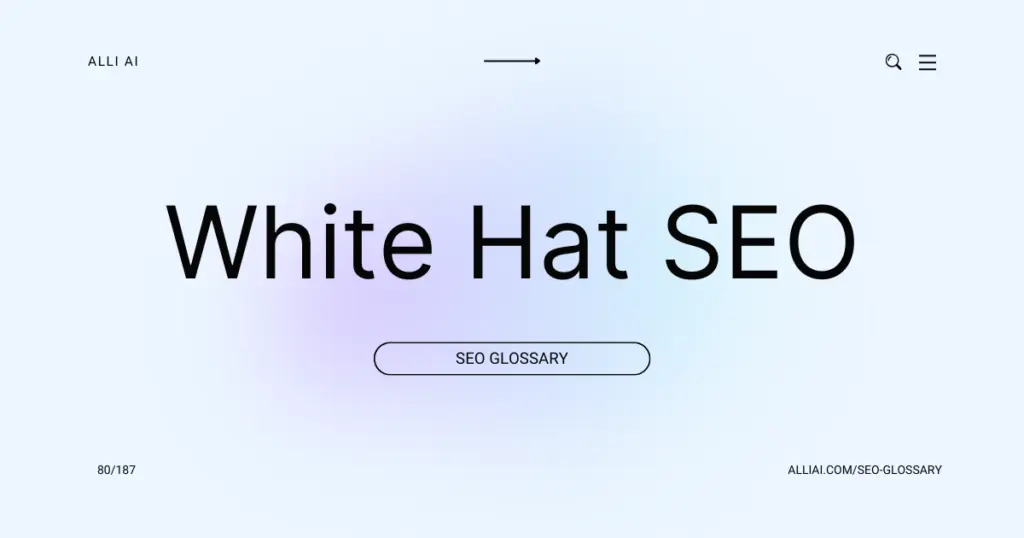What Does White Hat SEO Mean?
White Hat SEO refers to the use of optimization strategies, techniques, and tactics that focus on a human audience opposed to search engines and completely follows search engine rules and policies. It involves using techniques that are deemed ethical by SEO standards, which mainly means enhancing user experience and offering content quality, rather than trying to manipulate search rankings inappropriately. Techniques like using keywords, backlinking, link building to improve link popularity, and writing content for human readers are all examples of White Hat SEO. This approach aims for a long-term investment on your website as it is deemed to be more sustainable over the long haul.
Where Does White Hat SEO Fit Into The Broader SEO Landscape?
White Hat SEO refers to ethical and Google-approved SEO practices that focus on enhancing user experience while also adhering to search engine rules and policies. It forms a significant part of the broader SEO landscape, emphasizing long-term strategies to improve site authority and relevance, such as creating quality content, optimizing website speed and mobile responsiveness, and obtaining backlinks from reputable sources. These tactics ensure a sustainable and organically-grown ranking boost in search engine results pages (SERPs), contrasting with Black Hat SEO, which seeks to exploit loopholes and can eventually lead to penalties from search engines.
Real Life Analogies or Metaphors to Explain White Hat SEO
1. White Hat SEO is like gardening: Just as a gardener nurtures plants, follows seasonal cycles, and uses organic fertilizers to achieve a beautiful, sustainable garden, White Hat SEO involves using ethical strategies and practices to organically grow and nurture a website’s presence in search engine results over time.
2. White Hat SEO is a marathon runner: Unlike sprinters who aim for quick wins at any cost, marathon runners train methodically, abide by the rules, and focus on longer-term goals and endurance. Similarly, White Hat SEO values sustained efforts, playing by search engine rules, and building a lasting digital presence.
3. White Hat SEO is like building a house with proper permits and regulations. Just as a house must be built on a strong foundation with the right materials and adherence to building codes to ensure long-term safety and stability, White Hat SEO builds a website’s search engine ranking based on ethical guidelines and practices that ensure its reputation and rankings will stand the test of time.
4. White Hat SEO is a chef using high-quality ingredients: Just as a chef sources the best ingredients to create a nutritious and satisfying meal, White Hat SEO focuses on the quality of content, user experience, and ethical optimization techniques to feed search engines what they prefer, resulting in better organic rankings.
5. White Hat SEO is like a teacher following a curriculum: Much like a dedicated teacher who sticks to educational standards and develops students over the school year, White Hat SEO adheres to search engine guidelines and focuses on educating and engaging visitors, gradually improving a website’s search performance and authority.
How the White Hat SEO Functions or is Implemented?
1. Keyword Research and Optimization:
– Identify relevant, high-search-volume keywords using tools like Google Keyword Planner or SEMrush.
– Integrate these keywords naturally into the site’s content, including titles, meta descriptions, headers, and body text.
2. Quality Content Creation:
– Produce well-researched, original content that adds value for users.
– Focus on solving user problems or answering questions, maintaining high standards of grammar and clarity.
3. On-Page SEO:
– Ensure proper tag hierarchy (H1 for titles, H2 for subtitles).
– Optimize images and videos with alt tags and appropriate file names.
– Use short, descriptive URLs with keywords.
4. Technical SEO:
– Improve site speed by optimizing images, leveraging browser caching, and enhancing server response time.
– Make the website mobile-friendly.
– Implement SSL to secure the domain.
– Create an XML sitemap and submit it to search engines.
– Use schema markup to help search engines understand the content structure.
5. Link Building (Ethical):
– Earn backlinks naturally through reputable and relevant websites.
– Engage in genuine outreach for guest posting on well-regarded blogs.
– Create authoritative and informative content that naturally attracts links.
6. Social Media Integration:
– Promote content through social media platforms to drive traffic.
– Engage with followers to boost social signals, which indirectly influence SEO rankings.
7. User Experience (UX):
– Design an easy-to-navigate website layout.
– Ensure the website is accessible to users with disabilities.
– Reduce bounce rates by providing engaging content and a user-friendly interface.
8. Local SEO:
– Optimize for local search queries by including location-based keywords.
– Create and maintain a Google My Business listing.
– Encourage reviews from customers and respond to them to improve engagement and credibility.
9. Regular Monitoring and Updating:
– Use tools like Google Analytics and Google Search Console to monitor traffic, engagement, and site health.
– Regularly update content to keep it relevant and current.
– Adjust strategies based on analytical insights and algorithm updates.
Impact White Hat SEO has on SEO
White Hat SEO, focusing on ethical strategies compliant with search engine guidelines, positively impacts SEO performance, rankings, and user experience by:
1. Building long-term credibility with search engines through the use of quality content and organic link-building, leading to sustained ranking improvements.
2. Enhancing website usability and user engagement by optimizing site structure and content, which reduces bounce rates and increases time on site.
3. Improving site speed and mobile-friendliness, key for SEO and user satisfaction, which also contributes to better search engine rankings.
4. Increasing domain authority through the creation of relevant and authoritative content, which attracts quality backlinks and boosts SEO performance.
5. Ensuring website security (e.g., using HTTPS), which protects user data and improves trust, thereby positively influencing search rankings.
6. Avoiding penalties associated with Black Hat SEO tactics ensuring steady, penalty-free organic growth.
SEO Best Practices For White Hat SEO
1. Keyword Research:
– Use tools like Google Keyword Planner, Ahrefs, or SEMrush to identify relevant keywords.
– Focus on long-tail keywords which have less competition.
– Analyze search intent to ensure the keywords match what users are looking for.
2. High-Quality Content Creation:
– Create informative, engaging, and original content that addresses the needs and questions of your audience.
– Include the targeted keywords naturally within the content.
– Ensure your content is well-structured using headings, subheadings, and clear paragraphs.
3. On-Page Optimization:
– Optimize title tags to include main keywords and are under 60 characters.
– Craft meta descriptions that incorporate the keywords and are under 160 characters.
– Use header tags (H1, H2, etc.) to structure content effectively.
– Optimize images by using descriptive file names and alt tags that include relevant keywords.
4. Technical SEO:
– Improve website loading speed using tools like Google PageSpeed Insights.
– Ensure your website is mobile-friendly.
– Create an XML sitemap and submit it to search engines.
– Use HTTPS to secure your site.
– Ensure that your website’s URL structure is clean and keywords are effectively included.
5. Internal Linking:
– Link to other relevant pages within your website which helps spread link equity and increases page views.
– Use descriptive anchor text that informs the users what the linked page is about.
6. Backlink Building:
– Engage in ethical link-building practices like guest blogging, creating shareable infographics, and participating in relevant industry forums.
– Avoid buying links or participating in link exchange schemes.
7. Local SEO (if applicable):
– Claim your Google My Business listing.
– Optimize your listing with accurate details and high-quality images.
– Encourage customers to review your business on Google.
8. Content Update and Refresh:
– Regularly update old content to keep it relevant.
– Add new information, statistics, images, and check that all links work.
9. Social Media Engagement:
– Share your content on social media platforms.
– Engage with followers by replying to comments and creating interactive posts.
10. Monitor Performance and Iterate:
– Use tools like Google Analytics and Google Search Console to monitor traffic, rankings, and engagement.
– Based on data, make necessary adjustments to SEO strategies.
Common Mistakes To Avoid
1. Ignoring User Experience (UX): Prioritize UX by ensuring website design is intuitive and responsive across all devices.
2. Over-optimizing Content: Focus on creating valuable, informative content without excessive use of keywords. Aim for natural incorporation of keywords.
3. Neglecting Mobile Optimization: Implement responsive design and consider mobile-first indexing to optimize for mobile users.
4. Overlooking Website Speed: Enhance page load times by optimizing images, leveraging browser caching, and minimizing JavaScript.
5. Failing to Use Analytical Tools: Regularly utilize tools like Google Analytics to track website performance and user engagement.
6. Ignoring Metadata: Effectively use meta descriptions and title tags to improve visibility and click-through rates from search engine results pages.
7. Poor Quality Backlinks: Aim for high-quality, relevant backlinks over quantity. Avoid link farms and irrelevant directories.
8. Not Updating Content Regularly: Keep content fresh and up-to-date to maintain relevancy and authority.
9. Skipping Image Optimization: Utilize alt tags and compress files to both improve page load speed and provide context to search engines.
10. Not Focusing on Local SEO: For businesses with a local presence, ensure to optimize for local SEO elements like local keywords, Google My Business, and local listings.






